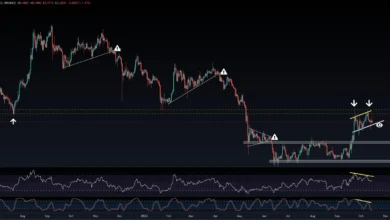Bitcoin’s Decline vs Ethereum’s Resilience: Crypto Market Outlook

Today, the Bitcoin Market is experiencing mixed fortunes; Bitcoin decline is somewhat declining, while Ethereum is holding steady. Bitcoin dropped to $107,000 as of May 28, 2025, causing a significant upset in the digital asset market. Ethereum, meanwhile, remains resilient at $2,650. Most altcoins are losing money, highlighting the persistent market instability. Examining why Bitcoin’s price has dropped, what is maintaining Ethereum’s value, and why most altcoins are declining, this article offers a thorough analysis of the current state of cryptocurrencies.
Factors Driving Bitcoin’s Recent Decline and Market Outlook
The pioneer of the cryptocurrency revolution, Bitcoin, has recently attracted considerable interest. Bitcoin has dropped somewhat from its recent highs, currently trading at around $107,000. Given the general expansion of Bitcoin, this drop may not appear significant, but it has raised questions among investors regarding its future course.
Examining both macroeconomic and microeconomic factors affecting the market can help one understand why Bitcoin has lost value. Macro-wise, investor sentiment has been significantly lowered by global inflationary pressures, tightening monetary policies, and ongoing regulatory scrutiny of the bitcoin sector. Although many investors view Bitcoin as a hedge against inflation, others have shifted to alternative assets for safer returns as traditional markets face uncertainty, thereby lowering demand for Bitcoin in the near future.

Another significant influencing factor is the impact of recent legislative changes. As concerns about their environmental impact and potential for illicit use persist, governments in major economies have begun tightening regulations surrounding cryptocurrencies, particularly Bitcoin. Stiffer rules in areas such as the European Union and the United States have contributed to a temporary decline in investor confidence, causing Bitcoin’s price to slide below key support levels.
Ethereum’s Resilience: Innovation and Institutional Support
Ethereum has maintained its position around $2,650, while Bitcoin is experiencing a decline. Several elements separate Ethereum from other cryptocurrencies and help to explain its price resiliency. Long understood as more than just a store of wealth, Ethereum is the cornerstone of most decentralized finance networks.
The backbone of many distributed apps (dApps), including decentralized exchanges (DEXs), lending systems, and NFTs (non-fungible tokens), Ethereum’s smart contract features have given the Ethereum network the capacity to run these distributed apps, lending it a special value proposition not found in Bitcoin.
Constant improvements to the Ethereum network also help to explain Ethereum’s pricing consistency. Successful in enhancing scalability, lowering transaction fees, and increasing network energy efficiency, Ethereum’s transition from Proof of Work (PoW) to Proof of Stake (PoS) has attracted institutional investors who view Ethereum as a long-term solution for building large-scale distributed applications.
Further bolstering Ethereum’s position with the emergence of Layer 2 scaling solutions like Optimism and Arbitrum is their improvement in transaction throughput and lowering of gas costs. As these technologies develop, new use cases on the Ethereum network will likely emerge, thereby sustaining the price of the token.
Factors Driving the Decline of Altcoin Prices
While Ethereum and Bitcoin remain relatively stable, most altcoins are currently losing value. Several factors can help explain the broad decline in altcoin prices: the declining value of Bitcoin, the prevailing market sentiment, and the high market volatility that characterizes the altcoin space.
Altcoins have historically been more volatile than Bitcoin, frequently exhibiting larger swings in both directions of price change. This volatility is primarily attributed to the tiny market caps of altcoins and their sensitivity to speculative trading. Often, dragging down the larger cryptocurrency market, including altcoins, Bitcoin’s price decline also affects other cryptocurrencies. This phenomenon, sometimes referred to as the “Bitcoin dominance” effect, occurs when the movement of Bitcoin’s price influences the overall market state.

Furthermore, spurred by hype and speculation, many altcoins have experienced inflated values during periods of strong market performance. These inflated prices typically deflate as the market corrects, which causes altcoins to see large price declines. Many altcoins lack the backing needed to withstand market declines without the solid foundations and use cases that Bitcoin and Ethereum have.
Although altcoin holders find the current market correction unpleasant, it does not always indicate their ultimate demise. Many altcoins are still in their early stages; therefore, long-term investors will continue to seek out interesting ideas with strong teams, compelling use cases, and increasing adoption. Genuine value propositions for cryptocurrencies will probably remain part of the ecosystem as the Bitcoin market develops.
Final thoughts
Looking ahead, it is challenging to predict exactly where the bitcoin market will go. Notwithstanding the transient difficulties, the long-term prospects for Bitcoin and Ethereum remain rather favorable. Major cryptocurrencies have a promising future indicated by the continuous evolution of distributed technologies, the rising institutional acceptance of digital assets, and the expanding number of use cases for blockchain technologies.
While Ethereum’s position as the preferred platform for distributed applications ensures its relevance in the broader blockchain ecosystem, Bitcoin’s role as a store of wealth and hedge against inflation remains underscored. The Cryptocurrency Market will likely remain volatile in the meantime, but there are still opportunities for notable gains if one focuses on projects with strong foundations and makes informed investments.




